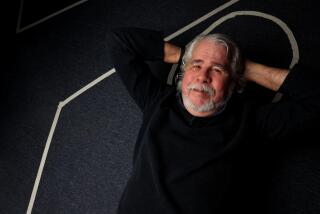A Lively ‘Dead Man’ in San Francisco
SAN FRANCISCO — On Saturday night, one day after the 400th birthday of opera in Florence, America added another specimen to its repertory for the lyric stage. New operas may not be as plentiful as they once were, but a time traveler from early 17th century Italy to the War Memorial Opera House, for the premiere of Jake Heggie’s “Dead Man Walking,” couldn’t help but be impressed by the appearance of a thriving art form.
A large audience was in attendance, and demand for seats has been so great that the San Francisco Opera, which commissioned the work, has added an additional performance to the seven that were originally scheduled. An Erato recording, taped at these performances, will be rushed into the shops before the end of the year, and the production will be revived next season by Opera Pacific. A commercial television news van was parked in front of the War Memorial Opera House, and public television documentarians were filming inside. Three hours after the curtain was raised, the crowd roared its approval in a substantial standing ovation.
“Dead Man Walking” is the latest in a recent string of newsworthy big-ticket American operas, including Andre Previn’s “A Streetcar Named Desire,” William Bolcom’s “A View From the Bridge” and John Harbison’s “The Great Gatsby.” The composer may not, this time, be well established; Heggie is known mainly for his agreeably singable songs that famous American singers enjoy singing. Nor does his subject matter come from classic American literature.
But “Dead Man Walking” offers its own kind of American glamour. It is based upon the book by Sister Helen Prejean about her experiences counseling death-row inmates that has made her a national figure and that was turned into a well-regarded Academy Award-winning film starring Susan Sarandon and Sean Penn. The libretto is by one of Broadway’s most successful playwrights, Terrence McNally (whose “Ragtime” happens to be playing in San Francisco a couple of blocks from the opera house). The director, Joe Mantello, is popular on Broadway as well, as an actor and director (his production of Eve Ensler’s “The Vagina Monologues” is about to open in Los Angeles.) And there was the specter of controversy, since Prejean is a leader in the fight against capital punishment.
Not to fear about the controversy, however. As grim as the subject matter may seem in its search to discover a shred of humanity in a barbaric murderer and rapist, “Dead Man Walking” is, to its core, a crowd pleaser created by artists who are also crowd pleasers in all that they do. Add, in Heggie’s case, a singers’ pleaser, as well.
McNally’s fluid libretto, utterly secure in its dramatic pacing and its ability to control the emotional climate at every microsecond, uses political issues mainly for local color as does, say, “Tosca.” Instead, “Dead Man Walking” is ultimately the spiritual quest of the highly appealing Sister Helen, her doubts and courage and intense search for meaning in a raw real world. The opera, however, goes out of its way not to take sides and “elevate” the issue to a quest for forgiveness. (The company’s general director, Lotfi Mansouri, notes in the program book that the major donor to the production is in favor of capital punishment.)
Heggie has responded with a kind of all-purpose sentimental lyricism in his vocal writing. His instinct is to flatter the voice, and he does so unfailingly. He sets words so well that we could have easily done without the projected titles. He also has the kind of feeling for the moment in theater that cannot be learned. One reason this opera held the crowd so well (and I can’t remember a time when I’ve heard fewer coughs in an American opera house) was that this was a compelling story simply told.
But that telling adds surprisingly little to the book or film, especially given the opera’s squirming fear of political commitment. Arias and ensemble numbers convey conventional sentiments of doubt, belief and guilt in conventional ways. Heggie’s musical ideas are not many. Redemption is found through quoting spirituals. Violent drama is mirrored in formulaic orchestral maelstroms. Simple, often derivative motives thread through the work without imagination. And by the end, Heggie’s climaxes have become so worn out that he finds it most dramatically effective to let important lines be spoken.
Still, the sheer stage-worthiness of “Dead Man Walking” does seem to have a life of its own. Heggie, McNally and Mantello, each in his own way, knows exactly how to get the most out of a theatrical situation, and the performance was superb. Susan Graham brought not just the ravishing beauty of her mezzo-soprano to Sister Helen but seemed to glow onstage. John Packard was the frighteningly intense convict, Joseph de Rocher. Frederica von Stade, one of Heggie’s earliest champions, gave a wrenching performance as De Rocher’s mother.
Even more impressive was the fact that every single person in the large cast seemed perfectly suited for his or her role and as natural as a character in a film. The show itself was well oiled--an efficient prison set by Michael Yeargan (who also designed “Streetcar,” “Gatsby” and “View from the Bridge”) worked well--and demonstrated the value of importing Broadway talent. Patrick Summers conducted with conviction; but, unlike the singers, the orchestra sounded unimpressed with its music.
“Dead Man Walking” has seven more performances through Oct. 28, $23-$165, War Memorial Opera House, San Francisco (415) 864-3330, https://www.sfopera.com.
More to Read
The biggest entertainment stories
Get our big stories about Hollywood, film, television, music, arts, culture and more right in your inbox as soon as they publish.
You may occasionally receive promotional content from the Los Angeles Times.











